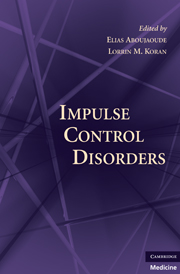
- Cited by 5
-
Cited byCrossref Citations
This Book has been cited by the following publications. This list is generated based on data provided by Crossref.
L'Abate, Luciano 2011. Recent Developments in Family Science in USA and Italy. International Journal of Brief Therapy and Family Science, Vol. 1, Issue. 1, p. 3.
Gysin, Fátima and Gysin, François 2013. Prostitution use has non sexual functions - case report of a depressed psychiatric out-patient. F1000Research, Vol. 2, Issue. , p. 70.
Karakaş Uğurlu, Görkem Uğurlu, Mustafa and Çayköylü, Ali 2013. The emergence of obsessive compulsive and compulsive buying symptomatology after acute stress and short-term use of ribavirin: case reports. Therapeutic Advances in Psychopharmacology, Vol. 3, Issue. 4, p. 246.
Fluck, Julia 2017. Why Do Students Bully? An Analysis of Motives Behind Violence in Schools. Youth & Society, Vol. 49, Issue. 5, p. 567.
Alić, Adi and Kadrić, Ahmed 2024. Effects of compulsive buying on debt avoidance and self-esteem: Can brand addiction serve as a socially responsible mediator?. Strategic Management, p. 68.
- Publisher:
- Cambridge University Press
- Online publication date:
- July 2010
- Print publication year:
- 2010
- Online ISBN:
- 9780511711930
- Subjects:
- Psychiatry and Clinical Psychology, Medicine, Psychiatry


